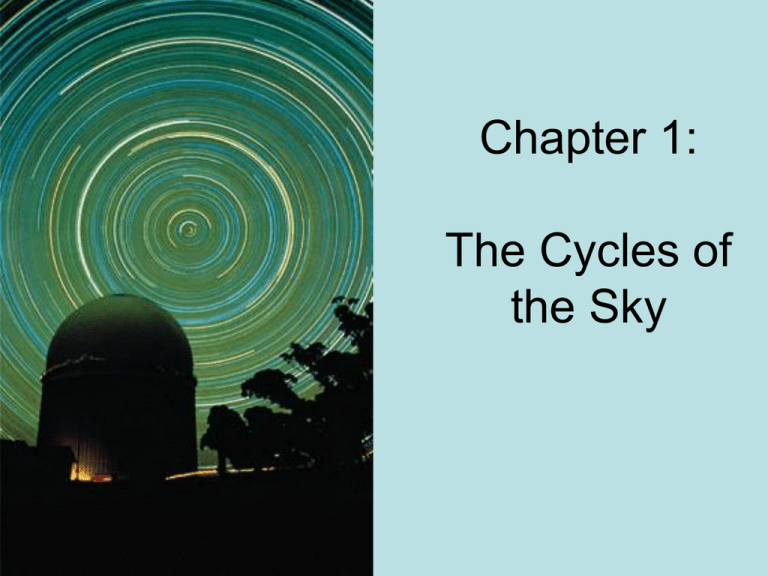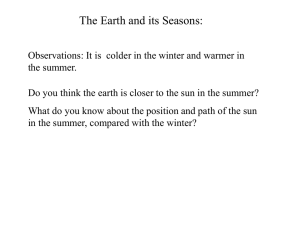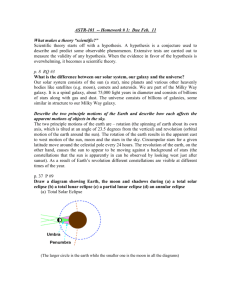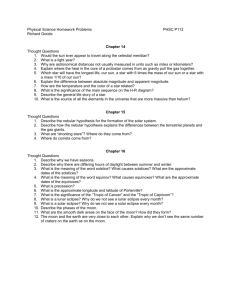Chapter 1
advertisement

Chapter 1: The Cycles of the Sky Constellations help astronomers know the positions of celestial objects Zodiac signs These coordinates can be used to describe the position of stars locally zenith Altitude Azimuth Angular distances of stars are measured in degrees An imaginary Celestial Sphere surrounding Earth aids in navigating the sky What is wrong with this cartoon? Rotation vs. Revolution • Rotation represents the Earth’s spin on its axis. • Revolution represents the Earth’s orbit around the Sun. • This defines the length of 1 day. • This defines the length of 1 year • 1 day= 24hours • 1 year= 365.25 days Earth’s counterclockwise rotation causes the Sun and stars to appear to move from East to West Motion of Stars at the North Pole Motion of Stars at the Equator Precession causes the position of the North Celestial Pole to change over a period of 26,000 years. UNLEARN Common Misconception The seasons occur due to the changing distance of the Earth from the Sun. When we are in our part of the orbit that is closer to the Sun, it is Summer, and when we are farther away from the Sun, it is winter This statement is NOT correct! LEARN Some Facts • When the Earth is physically closer to the Sun, it is winter time in the Northern Hemisphere, NOT summer • The Northern hemisphere and Southern hemisphere have opposite seasons from each other. • When the Earth is physically farther from the Sun, it is summer time in the Northern hemisphere, NOT winter Thus, Earth’s seasons are NOT caused by its changing distance from the Sun!!! Birds in the Northern Hemisphere fly south for the Winter... That is when it is winter in the Northern Hemisphere, it is summer in the Southern Hemisphere! ...which means that the Earth’s revolution around the Sun can not be the only explanation for seasons! The correct reason for the seasons: 1) the tilt of the Earth’s axis of rotation and 2) Earth’s revolution around the Sun Earth is tilted! Summer solstice Winter solstice Equinox position The “altitude” of the Sun impacts how much energy is received on Earth. Concept Question What would be different if the Earth had no tilt? UNLEARN Common Misconception The phases of the Moon occurs because as the Moon orbits the Earth, the Earth casts a shadow on the Moon and blocks some or all of the sunlight from reaching the the Moon causing the amount of sunlight reflecting off the Moon to change. This statement is NOT correct! LEARN The correct reason for the phases of the Moon: Although half of the Moon is always lit by the Sun, we can only see the side of the Moon that is facing the Earth and only on that side does the amount of illumination change as the Moon orbits the Earth. Concept Question If the moon was between the Earth and the Sun, what phase do you think it will be? A) full B) new C) first quarter D) third quarter In other words ... • The Earth’s rotation on its axis determines the length of the day. • The moon’s orbit around the Earth determines the length of a month. • The Earth’s orbit around the Sun (revolution) determines the length of the year. Lunar eclipses occur only when the Moon crosses the ecliptic during the full phase Lunar Eclipses Lunar eclipse only happens when the moon travels through the Earth’s shadow Darkest part of the shadow = Partial Full Partial Intermediate part of the shadow = Lunar Eclipses The moon is not completely dark during a total lunar eclipse Lunar Eclipses The moon is not completely dark during a total lunar eclipse since small amount of light is bent around the edge of the Earth’s atmosphere!!! Solar eclipses occur only when the Moon crosses the ecliptic during the new phase Solar Eclipses Moon = 400 X smaller than the Sun, but 400X closer The moon has the same angular size as the Sun! Solar Eclipse from Space Solar Eclipse Annular Eclipse Partial Eclipse Total Eclipse Solar Eclipses Next annular Last total solar eclipse eclipse visible visible in the in the U.S. U.S. was is May August 20, 2012! 21, 2017!







